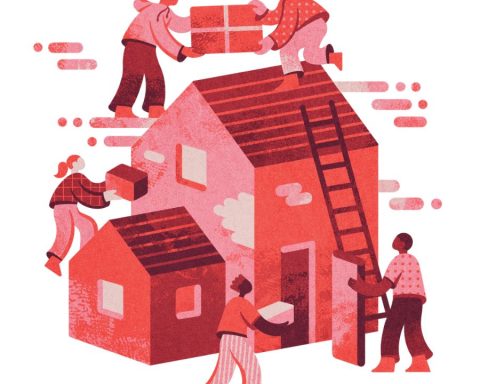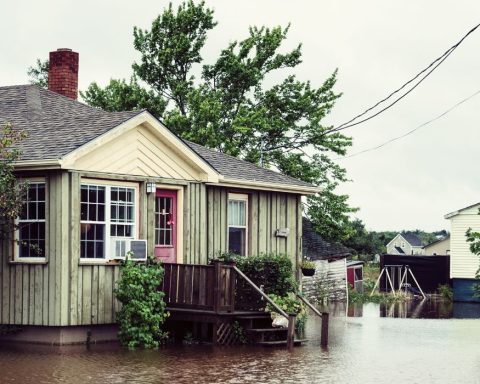An $800-million home retrofit program for lower-income households and a pledge to replace oil heating with heat pumps in new buildings are key elements of the federal government’s long-awaited Green Buildings Strategy, released Tuesday by Natural Resources Minister Jonathan Wilkinson.
The strategy brings together a smorgasbord of funding programs for buildings and energy efficiency, most of which the government has already announced, including measures from the 2024 budget that included $15 billion in apartment construction loans, $6 billion for infrastructure to support new housing supply and density, and $976 million for rapid construction of affordable housing.
But it contains no mandatory regulations or new public investments to bring emissions from the country’s more than 16 million homes, 564,000 commercial and institutional buildings, and 34,000 federal properties to net-zero.
“This was supposed to be a strategy to demonstrate how to achieve net-zero in the building sector,” Brendan Haley, senior director of policy strategy at Efficiency Canada, told The Energy Mix in an interview Wednesday. “It doesn’t deliver on that because it has neither mandatory performance standards for heating equipment in buildings, nor the public investments that would be needed to scale up retrofits.”
Over the last few years, Ottawa has often resisted calls to adopt ideas “that we felt were urgent and quick wins” in areas like low-income energy efficiency, deferring ambitious action until the Green Buildings Strategy could be finalized, Haley added. “The hope was that we would move away from these short-term pilot programs toward a long-term mission to make buildings more energy efficient, with performance requirements and supports that Canadians could count on in the coming decades, and that markets could plan towards.”
But now, “we’re left with a reannouncement of essentially pilot programs which are time-limited, and when they run out of money they could be abruptly cancelled like the Greener Homes grants.”
The document appears to contain no references to the phrase “natural gas”, prompting some speculation that Ottawa was wary of the criticism it could run into for a more robust approach to decarbonizing buildings, the country’s third-largest source of the greenhouse gas emissions that cause climate change.
“The government is moving in the right direction by attempting to decrease building emissions, lower household bills, and improve safety in homes,” Stand.earth said in a release. “However, the plan falls short by overlooking ‘natural’ gas, a highly polluting fossil fuel that is the most commonly used energy source for heating homes in Canada.”
Related:
- ‘Natural gas’ can not longer be the default option for heating new buildings: Report
- Abrupt end to Canada’s green retrofits program leaves industry in chaos
- What if government spent big on greening homes
The release of the strategy “was an opportunity to ensure that new homes would be built with clean and modern heating technologies, making them less polluting and more affordable to heat and cool,” added Stand climate campaigner Lana Goldberg. “By neglecting to develop a policy to address ‘natural’ gas in new buildings, the plan ignores the elephant in the room.”
That’s “mind-boggling” when “we have a high tech, high-efficiency, low-cost, modern technology to heat the air and water in our homes,” she told The Energy Mix. “This government needs to do what it knows it has to do to deliver on its commitments to reduce Canada’s greenhouse gas emissions, even if there’s backlash from industry groups that benefit from the continued use of natural gas.”
The Canadian Climate Institute assigned much of that responsibility to provincial and territorial governments. “In particular, they should accelerate investments in energy efficiency and building electrification, and stop expanding gas infrastructure for new development,” said Sachi Gibson, the institute’s research director for mitigation, in a release that cites the CCI’s recent report on the future of Canada’s gas networks.
“Our research has found that energy-efficient heat pumps are already the lowest-cost option for heating and cooling many homes in Canada today, and can help reduce pollution while saving people money.”
More Comprehensive Support
A centrepiece of the announcement is the $800-million Canada Greener Homes Affordability Program (CGHAP), which replaces the existing Canada Greener Homes Grant with “more comprehensive support for the installation of retrofits, at no charge to participating households,” Industry, Science and Economic Development (ISED) Canada said in a release. “Using a ‘direct install’ model, where the retrofits are managed and delivered by third parties, this program could provide participating households with support up to four times more valuable than the former grant program.”
Recommended retrofits under the program “will be determined by experienced energy efficiency professionals, enabling each participant to receive what their home needs and making their homes more affordable and comfortable.”
The announcement links to a Canada Mortgage and Housing Corporation (CMHC) landing page that describes a Canada Greener Affordable Housing program, featuring low-interest and forgivable loans of up to $170,000 per unit for retrofits and $130,000 per project for pre-retrofit activities. The program is targeted to older, primarily residential buildings with at least five units or beds.
The ISED release also commits to a “regulatory framework to phase out the installation of expensive and polluting oil heating systems in new construction, as early as 2028.”
“We will be moving to ban the use of heating oil in new construction. And that simply reflects the fact that there are lots of alternatives to heating oil,” Wilkinson told CBC. “Heating oil is enormously expensive, and it is the most polluting fuel that we use to heat our homes.”
The document. “offers few specifics on how the phaseout would work,” CBC notes, but “says it would include ‘necessary exclusions’ for places with insufficient access to electricity, or where backup standby heating is required.”
Building Sector of the Future
The strategy also sets out to “shape the building sector of the future” by working toward mandatory rules to replace air conditioners with heat pumps in new homes “and in certain retrofit scenarios”; Applying a “buy clean” policy that leverages federal procurement to promote low- and net-zero-carbon construction materials and designs; Updating the legislative tools in the federal Energy Efficiency Act to “account for the realities of today’s online retail environment”; Introducing consistent home energy labelling across the country; and toughening up the existing Energy Efficiency Regulations for air conditioners, water heaters, and some other home appliances and components.
“Greening the buildings sector remains a substantial and complex undertaking,” the strategy states. “Buildings have long life cycles and therefore reducing emissions, while also improving resilience to climate change, requires important investments that often need multi-year planning.”
With the private sector and financial institutions also playing a role, “strategies like maximizing utilization, reusing, refurbishing, and repurposing already built space provide a cost-effective way to help decarbonize Canada’s buildings stock by extending the lifespan of existing buildings and avoiding the energy-intensive process of creating new materials,” the document adds. And deep retrofits that upgrade multiple building systems and equipment “can achieve maximum energy savings and GHG emissions reductions.”
‘Quick Wins’ and Ambiguity
In a detailed assessment of the strategy, Haley says Efficiency Canada first suggested the requirement to “make air conditioners heat pumps” in a joint report last year with the Building Decarbonization Alliance, the Canadian Climate Institute, and the Greenhouse Institute. The policy, which is already in place in Vancouver, “ensures customers purchasing an air conditioner get the best product (that can also heat), increasing choices and opportunities to save money and improve comfort by operating the heat pump,” he writes.
The policy is “meant to be a quick win,” Haley writes, “an initial step in a regulatory pathway that would move to future requirements, such as requiring 100% efficient space and hot water heating systems.” But the federal version includes unnecessary restrictions that would undercut the benefits of the new rule, and also lacks a clear definition of a “net-zero end state”.
While eliminating heating oil amounts to “a consumer protection measure due to its high costs and risks,” the impact of the federal plan “is questionable due to its restriction on new buildings, which are unlikely to use oil heat,” he adds. “An oil heating phaseout would protect more consumers by applying to the replacement of systems in existing buildings and new ones.”
The strategy is ambiguous about Ottawa’s plans to require net-zero standards in new construction, including the minimum 3.5 million homes the government wants to see built by 2030. “An immediate action the government can take to meet its net-zero commitments and lock in affordability is to require housing built with funding under the National Housing Plan to meet net-zero standards,” Haley writes.
And while it recognizes the need to speed up energy retrofits to around 3% of the building stock per year, amounting to $400 billion per year in annual capital investment over the next three decades, “no federal public investments or performance standards that could trigger private sector activity are included in the plan.”
Needed: More Political Space
The strategy “helps clear the way for concrete policy implementation,” Haley concludes, opening the door to some “quick wins and immediate gains” through the Energy Efficiency Act amendments, the shift from air conditioners to heat pumps, the heating oil phaseout, and higher performance standards for federally-funded housing.
But it should also “create some reflection within the green building and energy efficiency community,” he writes. Despite “significant progress” in recent years, the strategy shows that “more political space has to be created for governments to move forward with the public investments or mandatory performance requirements needed.”
In Wednesday’s interview, Haley cited the federal government’s low-income energy efficiency program as a moment when public advocacy successfully pushed a new idea onto the government’s agenda. “What needs to be done is people, citizens, raising their voice and getting the attention of their political leaders,” he told The Mix. “More of that needs to be done, because we’ve seen that it works.”
But when that advocacy falls short, “if those policies are not being achieved or implemented, you can’t just blame the government for that,” he added. “You have to be a bit self-reflective about what else can be done.” On energy and climate policy, “the other reflection is why policies like energy efficiency equipment and green buildings, which are clearly a win-win, were not at the forefront of the recommendations for this government, instead of policies that don’t produce those co-benefits and don’t seem to make a lot of sense to people.”
Betsy Agar, director of the Pembina Institute’s buildings program, said the release of the Green Buildings Strategy will contribute to a conversation on how net-zero targets can be achieved.
“It’s a tool we can talk to any government about,” she said. “Now we can see the gaps, so we know what to push for.”
This article was first published by The Energy Mix. Read the original story here.







